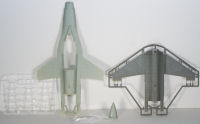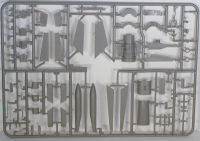
Eduard 1/48 F-16AM/F-16A ADF NATO Falcons Kit First Look
by Michael Benolkin
| Date of Review | September 2012 | Manufacturer | Eduard |
|---|---|---|---|
| Subject | F-16AM/F-16A ADF NATO Falcons | Scale | 1/48 |
| Kit Number | 1172 | Primary Media | Styrene, Photo-Etch, Resin |
| Pros | Versatile kit | Cons | See text |
| Skill Level | Experienced | MSRP (USD) | $74.95 |
First Look
 |
 |
 |
 |
 |
 |
 |
 |
For a quick history of the F-16, look here.
For a look at the differences between F-16 blocks, look here.
Eduard has released another kit in its outstanding array of enhanced reboxed models. In this release, we have the F-16AM in 1/48 scale and the this time the plastic comes from Kinetic. Kinetic was the first to release the F-16A with the variations in parts to render various NATO examples, most notably the F-16AM. You can see in the images that the bag shots came from several colors of styrene (okay, several shades of gray) but these will all be painted before you're finished.
To add value to the kit, Eduard has added their Brassin resin detail set for the ACES II ejection seat, wheels, and Pratt & Whitney F100-200 afterburner section and compressor face. In addition, there are two frets of photo-etched parts, one color-printed with the cockpit details, the other standard PE with airframe details. Finally no Eduard special edition would be complete without a stunning set of decals with a variety of markings options (more on this later) and a set of paint masks.
The kit is presented on 15 parts trees, plus two trees of clear parts. There are quite a few options provided, some of which aren't used in this kit. Before we can get into the features and options, let's take a look at the four subjects provided on the decals:
- F-16A ADF (Block 15 OCU), 7236, 5th Stormo, Italian AF, Cervia AB, Italy, 2010
- F-16AM (Block 15), 338 Sqn, Royal Norwegian AF, Tigermeet 2009
- F-16AM (Block 20), J-002, 323 Sqn, Royal Dutch AF, Leeuwarden AB, 2001, Diane
- F-16AM (Block 10), E-194, 370 Sqn, Royal Danish AF, 2010
So there are a variety of configurations that are needed in this one box to render those four aircraft. What they all have in common:
- Narrow-mouth intake
- F100 engine
- Lighter-duty landing gear/wheels
- Non-bulged landing gear doors
Now for the differences:
F-16A ADF: I don't believe the Italian AF F-16A ADFs received the cockpit upgrades applied to the F-16 MLU or CCIP programs, so the updated cockpit rendered on the photo-etched parts would not be correct for this version. On the other hand, the Kinetic kit is the first to get the APX-109 IFF antennas correct both in front of the windscreen and under the intake.
The F-16A ADF is also unique for the bulged fairings on either side of the base of the vertical stabilizer. The instructions have you use a standard F-16A base (this is incorrect) but the kit does provide the correct parts (E3/4) in the box. The instructions also have you use the landing lights mounted to the nose gear door as used on MLU (as well as Block 40 and later) aircraft. The F-16A ADF retained the original landing lights mounted on the main gear struts (which are also in the kit). In short, if you're going to build the Italian Viper, be skeptical of these instructions.
F-16A Block 15 MLU: Here is where the kit really stands out. The Norwegian and Dutch Vipers have the parabrake housing at the rear of the vertical stabilizer base (used to house additional avionics). These parts are in the kit and correctly called out in the instructions. The photo-etched cockpit will really set these versions off.
F-16A Block 10 MLU: I never did understand why the Danish AF didn't update their stabilators to the Block 15 OCU configuration when just about everyone else on the planet did. Nevertheless, not only did they retail the smaller stabilators, they didn't update them during the MLU process either. There are no Block 1-10 (small) stabilztors included in the kit, so you'll have to trim the kit stabs per the instructions (and then thin down the trailing edges) or seek out some aftermarket stabs.
Whichever version you opt to build out of this kit, it will look awesome. Regardless of how nice the basic Viper kit is straight out of this box, Kinetic also provides one of the best weapons sets for modern US armament I've seen in any kit. The AIM-9s are accurately shaped (as are the AIM-120s) and the missiles even have hollowed out motor bells in the rear. To recap all of the external stores options in this box:
- 2 x 370 gallon tanks for stations 4/6
- 1 x 300 gallon centerline tank
- 1 x AAQ-14 LANTIRN
- 1 x AAQ-33 Sniper XR
- 1 x ALQ-131
- 4 x AIM-9M Sidewinder
- 4 x AIM-9X Sidewinder
- 4 x AIM-120B AMRAAM
- 4 x AIM-120C AMRAAM
- 2 x AGM-65 Maverick
- 4 x Mk.82 (slicks)
- 4 x GBU-12 Paveway II
- 2 x GBU-24 Paveway III
- 2 x GBU-31 JDAM
- 4 x GBU-38 JDAM
- 4 x CBU-87
This is the nicest array of external stores that I can recall being included in one kit. You have enough external stores to bomb up this F-16, an A-10, and still have left-overs! Note that some of these items aren't used in this build like the X-Rays (AIM-9X) and the AIM-120C.
The Kinetic kit itself is well worth owning (several) and with the addition of the Eduard parts and features, you get most of your aftermarket needs addressed straight out of this box. As Kinetic released the variety of Viper variants in this series, the retail price fluctuated a bit but it looks to be currently around $60 USD. With a retail price of under $75 USD, this kit provides the equivalent of three Brassin sets, one photo-etched set, one mask set, and the great decal options, all for less than the cost of the basic kit and one detail set. Not bad. While it is a bit disappointing that the instructions don't properly address the F-16A ADF, there are plenty of online photos of the Italian AF Vipers to help you sort out the detail differences. Despite this glitch in the kit, this is still a great value and worth adding to your scale flightline!
My sincere thanks to Eduard for this review sample!







